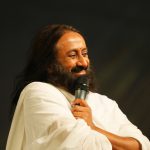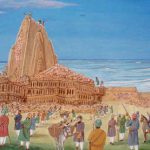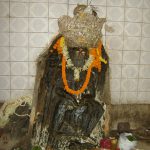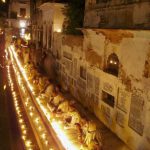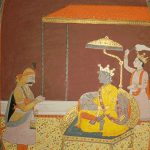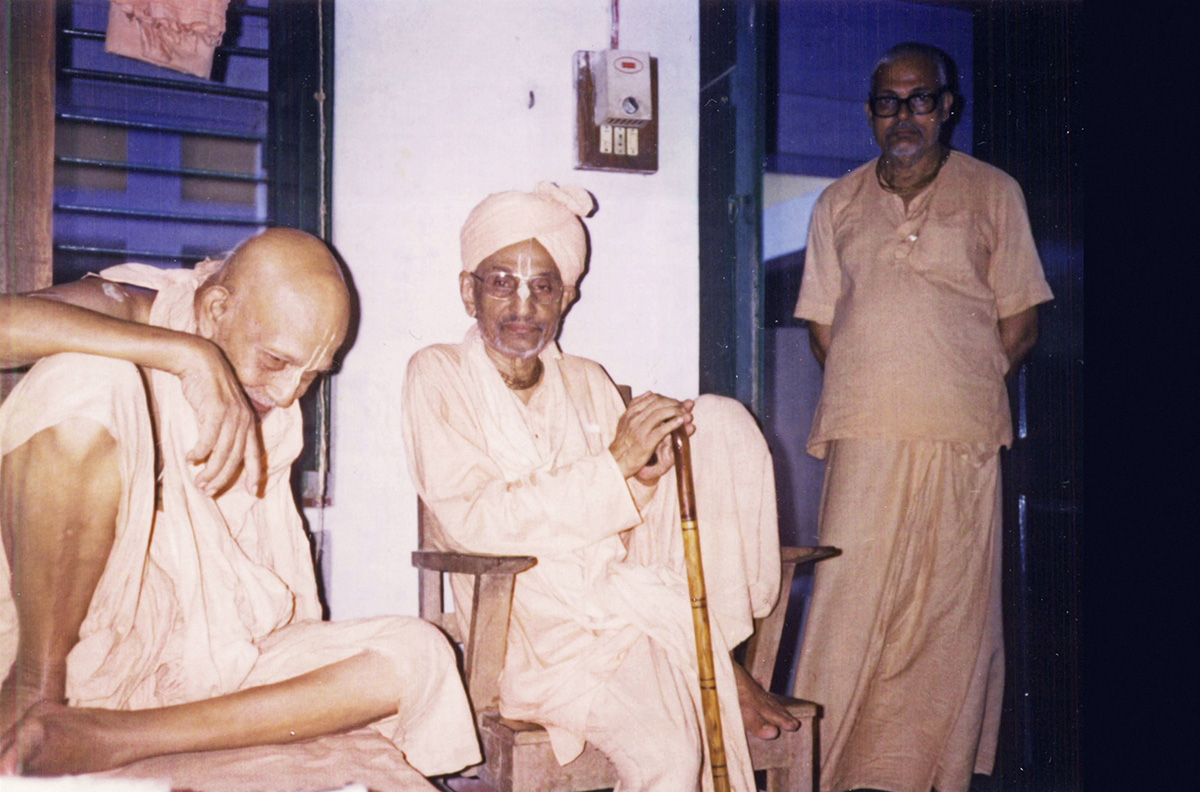
by Srila Bhakti Kumud Santa Goswami Maharaja
My respected listeners,
I was invited by my beloved Nandanandan to attend the celebrations being held on this occasion, the appearance day of Sripad Vamana Maharaj, Acharya of the Sri Gaudiya Vedanta Samiti.
I have recently heard that some persons who present themselves as initiated representatives of the Gaudiya Math are yet speaking many things full of apasiddhanta, contrary to established teachings. For example, some people are saying that a disciple should not observe his acharya’s birthday, but rather celebrate the day that he was initiated. This, however, is a completely erroneous idea. According to the Shastras,
isvarera janma-tithi jeman pavitra
vaisnavero janma-tithi teman pavitra
Just as the appearance day of God is holy, so too, the birth day of the Vaishnava should be celebrated as holy.
Those who think that the birth of their guru is a mundane event are truly unfortunate. Conditioned souls take birth in this world because they are bound by the results of their karma or past works. However, when God or the Vaishnavas appear, the meaning of such an appearance is quite different. When talking about the advent of the divine into this world, we do not use the word “birth,” but ävirbhäva, which means “appearance.” Similarly, when such great personalities leave this world, we do not use the word “death,” but tirobhäva or “disappearance.” The tithis or dates of the spiritual master’s appearance in the world are very holy to his disciples and are to be observed, for this will lead to devotion to Lord Hari. On the other hand, if a disciple does not observe such occasions, his neglect will have negative effects on his spiritual advancement.
e sab lilara kabhu nahi pariccheda
avirbhava tirobhava matra kahe veda
The Vedas say these pastimes never know interruption, they only appear and disappear to our vision. (Cbh 1.3.52)
The sun rises. This does not mean that it takes birth. It would be an error to think that. By the same token, when the sun sets, this does not mean it has ceased to exist. That too would be a faulty deduction. The sun’s rising is its avirbhava. Its departure means that it is invisible to our eyes, or tirobhava. The Lord and the Vaishnavas do not take birth under the laws of nature. When they breathe their last, this does not mean that they have died. Thus it is said in the Gita,
janma karma ca me divyam
evam yo vetti tattvatah
tyaktva deham punar janma
naiti mam eti so’rjuna
O Arjuna, the person who knows that My birth and activities are divine does not take another birth upon leaving this body, but comes to Me. (Gita 4.10)
Krishna’s birth and work are divya. Divya means eternal and transcendental. One kind of birth is conventional, material; the other is spiritual. It is an offence to identify spiritual matters with the conventional and the material.
Now those who have been initiated by Sripad Vamana Maharaj are extremely fortunate, but they should first of all try to understand what the spiritual master is or guru tattva and then proceed on the spiritual path. They should not pay heed to what others say.
I am old now. I have lost the ability to see and sometimes am unable to remember things that I know. However, I came here out of an urge to speak on these things, and so I jotted down a few points to speak on before coming and I will refer to them while speaking.
According to the shastras,
guru-padasrayas tasmat
krishna-diksadi-siksanam
visrambhena guroh seva
sadhu-vartmanuvartanam
First take shelter of a spiritual master, then take initiation and instruction from him. Then serve the spiritual master with faith and devotion and follow the path taken by the saintly devotees. (BRS 1.2.74)
If one desires to be a pathfinder to the spiritual realm and to find God, he has to take shelter of the lotus feet of a guru — adau guroh padasrayah. What is the meaning of asraya? Asraya means taking initiation or diksha. Here it says that one must not only take diksha from him, but also siksha, or teaching. And then what? The disciple is to serve the diksha guru with faith. He should bear in mind that if he serves the spiritual master, he shall receive great benefit. At the same time, he has to give up material dealings. He has to possess a spiritual faith:
sraddha-sabde kahe visvasa sudrdha niscaya
krishna-bhakti kaile sarva-karma krta haya
The word sraddha refers to a firm and confident belief that by engaging in devotion to Krishna alone, all of one’s duties will be fulfilled. (CC 2.22.62)
Faith means belief or visvasa. I shall give you an example of what that means: When Krishna was returning to the cowherd village after tending the cows, He learned that Sridama, Sudhama, Vasudhama and the other sakhas had lost consciousness due to drinking water from Kaliya’s lake. Krishna came running, slapped them on the cheeks to bring them back to life and asked, “What have you done? This water is poison. Even a bird that flies over this lake dies. So anyone who drinks it will surely die!”
How did Krishna’s companions answer Him? They said, “Kanai! Your friends do not love You with this sort of insignificant faith. The water we have drunk is not poison to us–it is nectar. It is impossible for us to drink poison and, even if we did, we would not die after drinking it.”
This is faith. Similarly, if I place faith in the guru’s lotus feet and carry out his orders, then I am engaged in an act of worship and I will benefit as a result. The disciple who goes forward with such faith will be rewarded with unlimited blessings. The chief blessing is that the guru will show him the way to Krishna. This is guru tattva; it has to be understood properly.
Furthermore;
tasmad guruh prapadyeta
jijnasuh sreya uttamam
sabde pare ca nisnatam
brahmany upasamasrayam
One who is inquisitive about the ultimate good in life should surrender to a spiritual master who has thoroughly understood the purport of the scriptures, is fixed in divine realization and has attained peace from the sense impulses. (Srimad Bhagavatam 11.3.21)
A guru has to be accepted to attain the greatest benefit. Why must we take a guru? Is accepting a guru nothing more than a conventional or materialistic act? It most certainly is not conventional. Jijnasuh sreya uttamam – here two words sreyah and uttamam have been used. Sreyah means welfare, but it is the uttama-sreyah—the supreme welfare and not some kind of fleeting materialistic benefit. One who is interested in obtaining this supreme welfare must take shelter of the lotus feet of a spiritual master.
What sort of person must the guru be? Sabde pare ca nisnatam–he should be well acquainted with the sabda brahman or “God as sound or revealed knowledge” and param brahman, “the supreme form of God.” The sabda brahman and param brahman are one thing, identical. The sounds of this world are all material. They are not the transcendental sound of çabda brahman. The sound of the supreme world is a transcendental one.
The guru is equipped with sabda brahman and param brahman. We cannot quite understand, but the spiritual master lives very near to God. We must have intuitive knowledge of this, for this is the reason we take shelter of his lotus feet and not for anything else.
What are the characteristics of such a guru? There are many such characteristics and a few of them have been named in the Hari-bhakti-vilasa (1.46)—.
kripa-sindhuh susampurnah
sarva‑sattvopakarakah
nihsprihah sarvatah siddhah
sarva‑vidya‑visaradah
sarva‑samsaya‑samchetta
nalaso gurur ahritah
The spiritual master is kripa-sindhu (“an ocean of kindness”) and daya-sagara (“a sea of pity”). He is susampurnah, full-fledged, in the sense that he is completely qualified. A disciple should not have any impression that his guru is incomplete in any way.
The guru is a benefactor of all beings, sarva‑sattvopakaraka. Whoever goes to him will be benefitted. Animate creatures will be benefitted by coming in contact with him, that is sure, but even inanimate objects will also receive benefits. This is my spiritual master’s shoe. Is it material or animate? It seems like a material object, but we are offering it our pranams. Because it been touched by our gurudeva, it has been turned into an object for our worship.
Sri Gurudeva is disinterested in anything, nihsprihah. He has no attachment, no hope or aspiration. He is always siddha (perfect), well-versed in all matters and expert in everything. He can put an end to all our doubts (sarva‑samsaya‑samchetta). He has the power to cut through all his disciple’s doubts. One who cannot answer his disciple’s questions is not a legitimate guru.
Furthermore, the spiritual master is not idle. He is not lazy. The person who possesses all these qualities can be called guru. Thus, not everyone can be a guru.
It is opined by many that the diksha guru and siksha guru are equal. This is not my opinion, for it is not in accordance with the scriptures. Yet some people take the two to be equal. Krishna Das Kaviraj quotes the following verse from the Srimad Bhagavatam—
naivopayanty apacitim kavayas tavesa
brahmayusapi kritam riddha-mudah smarantah
yo’ntar bahis tanubhritam asubham vidhunvann
acarya-caittya-vapusah svagatim vyanakti
Great philosophers could never find the limits of Your glories, O Lord, even if they should think on them with increasing joy for aeons. For, in the form of the intelligence within and the teacher without, You destroy all inauspiciousness and reveal the way You are to be attained. (SB 11.29.6)
Krishna’s long-lived devotees like Brahma think of the benefits You give them and become very joyful, but they cannot repay You for Your mercy. It happens because You destroy all the evils and sanction eternal well-being to all embodied jivas out of Your kindness. In order to do so, You appear as the acharya outwardly and the dweller in the heart.
Krishna is within me as the Chaittya Guru and He Himself appears externally in the world as the mahanta guru.
sikha-guruke ta jani krishnera svarupa
antaryame bhakta-srestha ei dui rupa
I understand that the siksha guru is identical with Krishna. He has two manifestations: one as the Supersoul and the other as the best of devotees. (CC 1.1.47)
The siksha guru is the exact form of Krishna. He has two positions – the dweller in the heart and the best devotee. As the Antaryami (dweller in the heart), He is also called the Chaittya Guru and as the bhakta-srestha (“best devotee”), He is also called the mahanta guru or diksha guru.
These are His two appearances. He who is there as the dweller in the heart is simultaneously apparent as the best devotee. This is the diksha guru. So by any other calculation, nothing objectionable will be found out.
Some say that a siksha guru more worshipable and salut able than a diksha guru. It is a wrong siddhanta. Why? The matter should be understood properly. According to the scriptures,
mantra-guru ara jata siksa-guru-gana
tanhara carana-age kariye vandana
I first offer my respectful obeisances at the lotus feet of my initiating spiritual master and all my instructing spiritual masters. (CC 1.1.35)
My Guru who initiated me and other siksha Gurus are to be offered pranams. First of all, the diksha Guru is mentioned and the siksha Guru is indicated afterwards. The diksha Guru is only one, whereas siksha Gurus may be many, indeed innumerable. Will every one of them be accepted as equal to the diksha Guru? No, on no occasion can that be done.
My spiritual master, Srila Prabhupada, gave me Harinam in Mayapur and then initiated me in Bagh Bazaar. After my initiation, all the other devotees began to address me as “Prabhu.” My name in brahmachari life was Radharaman Das, but everyone called me “Radharaman Prabhu.” I was then still a boy, so this made me uncomfortable. I went to Srila Prabhupada and said to him, “Prabhu, previously everyone addressed me as Radharaman. Why are they now calling me as Radharaman Prabhu?” Prabhupada laughed and said “Just see, some has called you prabhu and now you think that you really have become a prabhu.”
This is how teaching and practice go together. Vanity and pride may capture me. In order to make that pride weaker, the following teaching has been imparted — gurura sevaka hoy manya apanar “You must show respect for the guru’s servitors.”
One of my brother disciples asked me the following question: “Let us say that one of Bon Maharaj’s disciples is seated in an assembly where one of your disciples has also taken his seat. If a grand-disciple of your deceased senior Godbrother comes there, should he offer pranam to you or to Bon Maharaj?”
I answered, “He should offer pranam to his own guru first. But it is his guru’s duty to direct him thus: ‘Your guru-varga are seated here. Offer your pranams to them.’ If the sishya caries out the order, he will commit no offense. But he will certainly commit an offense if he does not offer pranam to his own guru first. The duty of the guru is then to direct his disciple to then immediately pay obeisances to his guru varga. This is the rule and system.”
The diksha guru is primary amongst all the different types of spiritual master.
mantra-guru ara jata siksa-guru-gana
There is a hidden aspect to this instruction. Many great disciples of Sri Keshava Maharaj are seated here. Other disciples may be younger in age and realization. Will they receive the same honors offer to the great sishyas? Will we commit an offense if we make an exception and treat one differently from another? Not everyone will get the honors offered the senior disciples, nor will he be considered as a siksha guru.
Who can be accepted as a siksha guru? He who teaches service to guru, Vaishnava and God, is a siksha guru. Someone not performing the above task should not be accepted as a siksha guru. Such a person is filled with vanity and cannot do anything beneficial for anyone.
The Shastras assert that the diksha guru is the siksha guru. When he initiates, he also teaches. In this matter, the diksha guru and siksha guru are identical; however, other siksha gurus do not deserve the same honors from a disciple. If one comes into a situation where both the diksha and siksha gurus are present, he should offer pranams to the diksha guru first. The siksha guru’s turn comes after that. If one meets both his father and uncle, should he first offer pranams to his uncle? Of course not. One first offers pranams to his father. The uncle can be honored afterwards. This is the conclusion that is to be obeyed.
Here is another point. A sishya can never be benefited by disregarding guru tattva. From the point of view of this material world, Srila Sanatan Goswami and Srila Rupa Goswami were brothers, Srila Jiva Goswami their nephew. Once Vallabhacharya came to visit Srila Rupa Goswami in Vrindavan. While they were conversing, Vallabha said, “Sri Rupa, you have written a very nice book, Bhakti-rasämåta-sindhu. However, there is one thing in that book that makes me quite unhappy. You have written—
bhukti-mukti-spriha yavat
pisaci hridi vartate
tavad bhakti-sukhasyatra
katham abhyudayo bhavet
How can the happiness of devotion find a place in the heart that is under the spell of the witch of aspiration for enjoyment and salvation? (BRS 1.2.22)
“You have here called bhukti and mukti a pisaci, which means witch or evil spirit. There are many persons who are in quest of moksa (salvation of the soul). Will they not take your words to be an insult? It is improper for a great personality like yourself to insult or abuse others.”
Since Vallabhacharya was his senior, Rupa Goswami acquiesced to his criticism, “I accept what you say.” Just mark what a Vaishnava is! How can we make any claim to be a Vaishnava?
Vallabha was satisfied and went to the Yamuna to take his bath. Jiva Goswami had been present while Vallabha talked with Sri Rupa Goswami and had heard the entire conversation. He followed Vallabhacharya to the bank of the river. When Jiva offered him pranam, Vallabha asked him, “My dear boy, who are you?”
Jiva Goswami said, “I am a lowly disciple of the person with whom you have just been speaking.”
“What is your name?”
“My name is Sri Jiva.”
“What do you want to say to me?”
“You refuted the siddhanta of my guru, but it was not something that should have been refutated. He has written the right thing.”
“How so?”
“My spiritual master wrote that the aspiration (spåhä) for bhukti and mukti is an evil spirit, not that bhukti and mukti are themselves evil spirits. It is the same as saying that a bad attraction to women is to be abhorred; that does not mean that women are to be hated. It is not acceptable for anyone to say that the female sex should be hated. This is what we have been given to understand. So how can you argue that Rupa Goswami has spoken improperly?”
Vallabhacharya meditated on what Jiva had told him and came to the conclusion that he was right. After bathing, he came back to Rupa Goswami and said, “Sri Rupa, what you have written is correct. You asked us to bid goodbye to bhukti-mukti-spåhä. The aspiration for enjoyment is described as a bad thing. There is no need for you to exclude it from your book.”
Rupa said, “What makes you say this, Prabhu? Just a few minutes ago, you told me that I was wrong. What has made you change your mind?”
“My error has been corrected by a handsome boy.”
“What boy?”
When Vallabha told him, Rupa thought, “Well this is a fine state of affairs.” Then when Vallabhacharya had gone, Rupa Goswami said to Jiva, “I shall not look at you. You are not fit for life in Vrindavan. You are still afflicted by vanity. You think that you are such a great person that you went to debate with Vallabhacharya, whom I consider my superior.”
Jiva Goswami was Rupa’s own sishya and nephew. Jiva did not utter a single word against his guru’s verdict. He did not argue that it was unjustified. Instead, he went to Nandagram near the Yamuna and began doing his bhajan. At first, he lived on madhukari, a single handful of food each day. Then, he gave even that up and simply sat down chanting Harinam all day long.
At the time, Sanatan Goswami happened to be walking through the twelve forests of Vrindavan. One day, as he passed through Nandagram, the local people said to him, “Please come and see. A handsome boy has come to live here. He constantly utters the names of Hari, but he does not eat any food. He may die. Please come and see him.”
Sanatan Goswami followed them and was surprised to see that the boy they were talking about was his nephew. “What is this, Sri Jiva? Why are you doing this? You are going to kill yourself!”
Sri Jiva answered, “Prabhu!” — he never addressed him as uncle – “My life is without meaning, for I have lost the mercy of my guru. What is the value of the life of someone who is bereft of his spiritual master’s blessings and has been abandoned by his spiritual master? It is better that he die. I think that death is preferable for me.”
Sanatan asked Jiva to tell him the whole story. Jiva explained, “I could not bear to hear any condemnation of my guru, so I protested. As my gurudeva is displeased with me, I prefer to serve him in separation. I am now separated. I do not want to give any further trouble to my gurudeva.”
Sanatan Goswami did not say anything further to Sri Jiva. Instead, he went back to Sri Rupa and said, “Sri Rupa, Jiva is going to die unless you have pity on him and show him some kindness.”
Sri Rupa Goswami said, “Yes, I shall do it.” He went running to Sri Jiva and said, “My dear son, come to me.” So Sri Jiva Prabhu has given us an example of great devotion to the guru. Srila Prabhupada directly told us all these siddhantas. We have to obey them. That will be most beneficial to us. So it is said in the scriptures—
acaryah mam vijaniyan
navamanyeta karhicit
na martya‑buddhyasuyeta
sarva‑deva‑mayo guruh
A disciple should consider his teacher to be My very self and never disrespect him in any way. One should not envy him, thinking him to be an ordinary man, for he is the sum total of all the demigods (SB 11.17.27).
The spiritual master should not be judged from the material point of view. Krishna says, “The acharya is the same as me. Mam viyaniyat — know that he is like Me. Navamanyeta – never dishonor or censure him. Why? Sarva-deva-mayo guruh. All the powers of the demigods are possessed by the spiritual master. By the grace of the Lord, he has received the power to show kindness–he has learned to be all-powerful. How? He can give the all-powerful Lord. This is something that cannot be given by any other person, not even the demigods. So, in this way, the diksha guru has been given a great deal of importance. This is how we have to consider the spiritual master.
Adau guru-puja–first of all, the guru is to be worshiped. Who is being worshiped? Is is the siksha guru or the diksha guru who is being refered to here? First of all, the diksha guru should be worshiped, not the siksha guru. Tulasi Das has written–
guru aur govinda do khare hain kisko lagun pau?
jo guru go lage usko balihari jae
If you should see the guru and Govinda Himself standing together, to whom should you offer your obeisances? I praise him who first offers obeisances to his guru.
If I see the diksha guru and Govinda standing in front of me, to whom shall I offer my pranams first? One should first offer pranams to the guru and then to Govinda. Would the same siddhanta apply if it were the siksha guru? I think not. The status of the siksha guru cannot be greater than that of the diksha guru. The only thing in common is that diksha guru is also a siksha guru.
sad-guru pawe veda batawe jnana kare upadesa
tou kaila ki maila chute jau ag kare paravesa
If you get a Sat Guru, He will show you the right path and give you proper knowledge. It is just like a fire destroying all the dirtiness of coal.
What is meant by the term Sat Guru? He is the one who shows the Veda or the way—
jnana kare upadesa. He gives tattva-jnana—
ajnana-timirandhasya
jnananjana-salakaya
caksur unmilitam yena
tasmai sri-guruve namah
I offer my pranam to the guru who takes away the darkness of my ignorance and gives birth to my eyes with the stick of His knowledge.
Kaila ki maila chute. Coal is dirty; but after it has been burned by fire, its dirtiness is eliminated. In the same way, when the fire of the gurudeva’s instruction enters the sishya’s ears, the dirty things—the darkness and bad tendencies remaining in the sishya—will be burned to ashes. Thereafter, the disciple will be able to see the Lord. The heart is either transparent or opaque, like a glass, which if clean, we can see through. On the other hand, if dirty, the glass becomes opaque and we can see nothing at all through it. When the heart is clean, one can see his true self and Krishna, the Supreme Self.
I once went on a preaching tour to Dhaka, Narayan Ganj, Mymensingh, Dinajpur, Khulna, Jessore and other places in Bangladesh. One Muslim asked me, “Sir, you talk of God by using the names Bhagavan and Hari. We, on the other hand, utter the name Allah. In either case, He is not visible. Where is He? How can I identify Him? Have you seen Him?”
What could I say to this man? I answered in the following way, “Yes, I have seen Him. Listen to this example: A play is staged thousands of miles away in London, England. Here in front of you is a television and you can watch what is happening so far away. How can that be so? It is possible because of the ether through which the images are transmitted. You can also make your mind into a type of television receiver. If you do that, you will be able to see that the Lord comes to you from Goloka. You will be able to see Him. However, without such an arrangement, it will not be possible for you to realize Him.”
Here is another example: A young man loves a girl, but she is not here. She lives in Bombay. Though she is in Bombay, she lives in her lover’s heart. If you love the Lord in the same way, He will take a seat in your heart despite being eternally present in Goloka. He Himself has said,
sadhavo hridayam mahyam
sadhunam hridayam tv aham
mad-anyat te na jananti
naham tebhyo manag api
Sadhus are My heart and I am the heart of the sadhus. Sadhus do not know anyone other then Me. I also know no one other then the sadhus. (SB 9.4.68)
What is this? Krishna, here You say that You are in the heart of the sadhus. But elsewhere You also say that You are aware of every jiva. Krishna says, “Yes, I take My seat in every heart and am aware of it. Thus, whenever anyone suffers from life’s miseries, I suffer along with him. Living in the heart of a devotee, however, I do not suffer from these miseries, so I get a special pleasure from residing there. I feel happy by observing the devotee’s serving attitude.”
The Shastras say–
yasya deve para bhaktir
yatha deve tatha gurau
tasyaite kathita hy artham
prakasante mahatmanam
Only unto those great souls who have implicit faith in both the Lord and the spiritual master, who is His manifestation and not different from Him, are all the imports of Vedic knowledge automatically revealed. (Svetasvatara Upanisad 6.23)
The guru must be seen as in no way inferior to the Lord—
brahmanda bhramite kona bhagyavan jiva
guru-krishna-prasade paya bhakti-lata-bija
In the course of traversing the universal creation of Brahma, some fortunate soul may receive the seed of the bhakti‑lata, the creeper of devotional service. This comes about by the grace of guru and Krishna. (CC 2.19.151)
tate krishna bhaje kare gurura sevana
maya-jala chute paya tabe krishnera carana
He then worships Krishna while continuing to serve the guru’s lotus feet. As a result, he is freed from the illusory entanglements of material life and attains Krishna’s lotus feet. (CC 2.22.25)
By the grace of guru and Krishna a fortunate person gets the seed of devotion after he has wandered all around the universe. If the disciple worships Krishna and serves His guru, the curtain of Maya covering him will disappear and he will attain Krishna’s lotus feet. Go on executing Krishna’s bhajan. If anyone goes on doing bhajan, the coverings of Maya will vanish and he will get the lotus feet of Krishna. Otherwise, there is no way to get it. This aim will not be reached without the mercy of a guru.
Not every Tom, Dick or Harry can be a guru.
vaco vegam manasah krodha‑vegam
jihva‑vegam udaropastha‑vegam
etan vegan yo visaheta dhirah
sarvam apimam prithivim sa sisyat
A sober person who can tolerate the urge to speak, the mind’s demands, the actions of anger and the urges of the tongue, belly and genitals is qualified to make disciples all over the world.
These are the forces of the world–speech, mind, anger, tongue and belly. He who controls these forces is worshiped by all the world.
e chay vega jar sada base roy
se hon gosvami tare prithivi pujoy
He who controls these six is a Goswami and is worshiped by all the world.
The word gosvami has two meanings. Go means cow. The husband of a cow is an bull, a very lustful creature. Again, go means senses. One who is the husband of the senses or has controlled them is also called a go-svami. He is not a servant of the senses; he has conquered the world. Our well-being will appear when we come in touch with such a person.
acinoti yah sastrartham
acare sthapayaty api
svayam acarate yasmad
acaryas tena kirtitah
The acharya is the title given to the spiritual master because he has studied and understood the meaning of the scripture, establishes this meaning in the behavior of others, and himself practices what he preaches (Manu-samhita).
So Mahaprabhu Himself played the role of an acharya. As He says in Chaitanya Charitamrita—
apani acari bhakti sikhaimu sabare
apane na kaile dharma sikhana na yaya
I shall take the part of a devotee, and I shall teach devotional service to all by practicing it Myself. No one can teach religious activities to others without putting them into practice himself. (CC 1.3.20-21)
He who goes through life with proper dealings and teaches others the lesson is an acharya or guru.
In the scriptures, gurus have been given more importance than the Lord. Our Gurudeva said, ”If the Lord Himself comes and says, ‘I am the Supreme Godhead,’ I shall say to Him, ‘You may go away.’ When my Gurudeva comes and says, ‘See, here is the Lord,’ then shall I bow down my head.”
There is a saying;
kobe anguli nidesa kori more dekhaibe
When will you show me what you want me to do just by pointing your finger?
Why does Narottam Das sing sri-rupa-manjari-pada, sei mora sampada—“The feet of Sri Rupa Manjari are my treasure”? Does this not have something to do with guru tattva? This matter should be clearly understood. We must understand both how to act and how to speak.
Nowadays there is a debate concerning the difference between the diksha and siksha gurus. Some people say that the diksha guru and the siksha guru are to be honored on the same platform. I admit that a siksha guru is to be honored, but it should not be done in the presence of the diksha guru. The Chaittya Guru has made Himself visible in two different forms. How so? As the siksha guru and mahanta guru.
A mahanta guru is also a siksha guru. Is a guru free from all responsibilities after initiating his sishya? Must He not teach his sishya–“My dear son, follow this path. You should process your life in this way”? So, (a) the Chaittya Guru, Sri Vyasa Deva, is the diksha guru and (b) the diksha guru is also a siksha guru.
Will other siksha gurus not impart lessons also? They will also teach the disciple how to serve the Lord after obeying the diksha guru. If a siksha guru fails to teach the aspirant how to obey the diksha guru, he is not a true siksha guru. What is the value of his siksha? What welfare will come to the world through him? None at all. He should show the disciple the procedure, “My dear son, follow this way.” He will show the way to go to the diksha guru. He tells the disciple, “If the diksha guru is merciful, you will see the Lord afterwards. Otherwise, you will fail to get Him.”
So the shastras enjoin—
guru krishna-rupa hana sastrera pramane
guru-rupe krishna kripa karena bhakta-gane
According to the scriptures, the spiritual master is a form of Krishna. Krishna takes the form of the guru to bestow His mercy on the devotees. (CC 1.1.45)
Why have these lines been written? There is a judgment in them. One group of people sees the guru as an embodiment of mercy of the Lord. Another says that the guru is God Himself. They are of the opinion that we have no need for a deity of the Lord when the guru is present, filling that position. We in the Gaudiya Math, however, do not accept this idea. The siddhanta has to be understood. The king and the representative of the king are two different persons. The representative of the king is not a king. He also receives his due honors. As the king has not come, his deputy, the viceroy, gets the honor due the king. But the viceroy is not the king. In the same way, the Lord’s deputy or representative is the gurudeva.
God Himself says—
na me bhaktas catur-vedi
mad-bhaktah svapacah priyah
tasmai deyam tato grahyam
sa ca pujyo yatha hy aham
A non-devotee Brahmin is not dear to Me, even if he is learned in all the Vedas. On the other hand, an outcaste who is My devotee is My beloved. One should give gifts to such a devotee and accept his blessings, for he is as worshipable as I am.
The guru is to be worshiped like God, because you will not get Krishna without his mercy. So this Lord, gurudeva, the servitor of God, is the sevaka Bhagavan. On the other hand, the Supreme Lord Himself is the sevya Bhagavan (the Lord who is being served). If the guru was the Supreme Lord Himself, the following verse could never have been written—
akhanda-mandalakaram
vyaptam yena caracaram
tat padam darsitam yena
tasmai sri-guruve namah
I offer my obeisances to the spiritual master who has shown me the Supreme Truth, the unbroken circle that encompasses everything and which penetrates all beings, moving and non-moving.
The one who shows us the Supreme Lord’s lotus feet is Sri Gurudeva. Thus, we must ask whether the guru puts his own foot forward and says, “I am the Lord, bend your head here”? He most certainly does not.
From our point of view, the spiritual master is the sevaka Bhagavan. He will help me reach the lotus feet of the Lord. He who does not have the capacity to help us reach the lotus feet of the Lord should not be accepted as a guru. There is an example of this in the life of the Lord’s incarnation, Vamana Deva. Lord Vamana went to Bali Raja and asked him for alms. Vamana Deva went to the head of the line, before all the other mendicant Brahmins who were waiting for Bali Raja’s generosity. The greedy Brahmins said to one another, “This child is going ahead of us in the line. He will ask Bali Raja for something extravagant and then we shall not get anything.” So they laid hold of Vamana Deva and made Him go to the back of the line. However, when they reached Bali, they found that the dwarf-figured Vamana was already standing near the king. They said, “Alas! We placed him behind us, but now he is here in front of us again! What has happened?”
Bali Raja said to Vamana Deva, “Tell me what you want?” Vamana said, “I do not require anything. I only want three pieces of land for the three steps of my feet.”
The Brahmins felt relieved. They thought, “Hello, you should beg for something more. Instead you are asking for just to get three steps of land. How long are your steps? What a fool you are!”
Bali Raja said, “You are not thinking of Your interest. Ask for something more. I shall give You whatever You ask.”
Vamana said, “No, I am not in need of anything more. The land covered by My three footsteps will suffice.”
At that time, Bali’s guru Shukracharya came on the scene. Shukracharya was not an insignificant personality, but one of importance with great learning and ability. He asked Bali; “What are you doing?” Bali replied, “I am giving in charity to the Brahmins. Do you know this man?”
Shukra said, “No, I do not know Him, but I believe that He is the Lord Himself. He will take everything you own and leave you nothing at all.” It reminds us of the words of a modern guru: “If He takes all you own, what shall I eat? How will you maintain me?”
Bali Maharaja said, “What are you saying? Is He the Lord?” Shukracharya’s answer came in the affirmative. “Then that is very good,” said Bali. “I shall be benefited from two sides. If He is the Lord Himself, He will remove everything, including my sins and my suffering. If He is not God, then He will simply accept three footsteps of land. In either case, I have nothing to lose.”
There was a rule then. At the time of donating anything the word Om was to be pronounced while sprinkling water from a special waterpot used for religious purposes. Bali Raja tried to take the water from such a pot, but none came out. Then Vamana Deva said, “Clear the spout with a pin.” After the use of the pin, Shukracharya came out from the spout as a blind person.
Why is Shukracharya described here as a “blind” person? According to the verse sruti-smriti upanetre, Sri Vamana Deva has two eyes, the Sruti and Smriti (the hearing capacity and memory). Sruti is a mother. The mother of a son reveals the father to her son. Only she can definitively say, “That is your father.” If the son has not seen his father, will he be able to guess his father’s identity? The child’s mother must tell him everything. In the same way, Sruti or the Veda is the mother. The Smriti, on the other hand, discloses how he is to serve his father.
Here Shukracharya only played half the role of acharya. Like the Sruti, he pointed out to Bali that Vamana Deva was the Lord, but he restrained the king from rendering service to Him. So he is sometimes described as a blind man, or one who saw through only one eye. Bali Raja, however, did not obey his acharya. He said, “I shall disobey you. I shall make an offering to Vamana despite what you say.” In saying this, he rejected his guru.
Vamana Deva then took over the Heavens, the Earth and the Netherworld with His first two steps. Are any of these gurus who refuse to set up a deity of the Lord and declare themselves to be the Almighty able to take a single step from this spot to the temple of Puri? If there is one who can, then I shall give up everything and become his disciple.
But that was not the end of Vamana Deva’s pastime. He then asked Bali to give Him a place where he could place His foot for the third step. It was not then known that Vamana could still take a third step like His first two. Nevertheless, He showed His third foot at that time, placing it on Bali Maharaja’s forehead. Are any of these so-called gurud who has described himself as the Lord capable of doing this?
Our siddhanta is that the guru is the Lord, but he is the Lord in his form as a servant, the sevaka Bhagavan. He is there to serve the sevya Bhagavan, the Lord as object of service. No person other than the guru can give the Lord. No one has this capacity. This is the siddhanta, the judgment we must accept.
So, guru-rupe krishna kripa koren bhakta-gane, “As the guru, Krishna shows His mercy on the devotees.”
Now some persons may point out verses in the scripture that speak of the siksha guru’s importance.
siksa-guruke ta jani krishnera svarupa
antaryami bhakta-srestha ei dui rupa
I understand that the siksha guru is identical with Krishna. He has two manifestations: one as the Supersoul and the other as the best of devotees. (CC 1.1.47)
The siksha guru has been divided in two parts. As the dweller in the heart, He is Chaittya Guru. As the best devotee, he is the mahanta guru or diksha guru. The teaching of other siksha gurus to the effect that they are better than the diksha guru is not acceptable.
What type of guru is Shukracharya? He is not a proper guru, just like Parashuram. Bhishma Deva abandoned his guru, Parashuram. Why did he do so? Parashuram is a shaktyavesh avatar of the Lord. Bhishma Deva was his disciple. Bhishma brought Amba, Ambika and Ambalika after he had conquered Kashi. Ambika and Ambalika were married to his brothers, Vichitravirya and Chitrangada respectively. The third sister Amba loved Salya Raja, but he refused to marry her because she had been carried away by Bhishma. Amba then wanted to marry Bhishma, but he also refused her because he had promised to remain unmarried. He told her to go to his guru, Parashuram, and if he told him to marry, then he would do so, for ajna gurunam hy avacaraniya – “The guru’s order must be followed without making any judgment.” Amba then went to Parashuram, who directed Bhishma to marry her. But Bhishma said to Parashuram, “What kind of spiritual master are you? I have promised to remain unmarried throughout my life. I shall keep this vow. Being my guru, you know this, but still you are telling me to get married?” Parashuram said, “I am your guru and I direct you to marry.” Then Bhishma said,
guror apy avaliptasya
karyakaryam ajanatah
utpathapratipannasya
parityago vidhiyate
“If a spiritual master is disreputable, if he does not know right from wrong, and if he himself has taken to a path of irreligion, he should be abandoned.” [Mbh 5.178.24]
Normally, the order of the guru is to be obeyed when he instructs his disciple to get married; but if the guru goes astray, he is to be forsaken. The rule is that one should abandon a guru who follows a contrary path. Thus Bhishma left his guru. His guru then said, yuddham dehi – “Fight with me.” Bhishma fought against his guru for eighteen days and finally defeated him. He is, therefore, called “the conqueror of Rama,” meaning Parashuram.
The outward duties of a guru are not his real business. The real guru is one who can show us the lotus feet of the Lord. I may think, I have gained some psychic power and so I shall be a guru by virtue of this power. That is not possible. Yogis attain divine grace through their austere religious practices—anima, laghima, isita, vasita, and so on. The Lord is not available through such austerities, however.
jive saksat nahi tate guru caittya-rupe
siksa-guru han krishna mahanta-svarupe
Since one cannot directly experience the guru as the Supersoul, Krishna appears as the siksha guru in the form of a highly advanced Vaishnava. (CC 1.1.58)
Jivas do not have any perception of the Chaittya Guru’s presence—siksa guru hon krishna mahäanta svarupe. So Krishna becomes the guru by taking the form of the mahanta, or highly advanced Vaishnava. The mahanta guru is the diksha guru. A siksha guru is never been described anywhere as a mahanta guru. This is clearly stated here. Anyone desirous of challenging this interpretation is welcome to try.
Does one become a diksha guru simply by teaching about Bhagavan? A siksha guru will teach one to faithfully render service to one’s diksha guru. If the siksha guru excludes the diksha guru and becomes “Brahman” simply by uttering aham brahmasmi (“I am Brahman”), it will be a total massacre. The diksha guru is a mahanta guru. He has come to deliver the jivas.
The guru is of two types – nitya-siddha and sadhana-siddha. The Lord sends a guru after making him nitya-siddha. Sometimes he sends a sadhana-siddha. If a diksha guru is sent by the Lord, he will make disciples to deliver them. Thus he is described as a mahanta guru. He obeys the order of the Lord. The matter should be understood properly.
When Buddhism pervaded the world, preaching the religion of kindness, the Lord Himself called Shiva and said to Him, “Go to the world. Once there, distort the meaning of the Vedas–
dvaparadau yuge bhutva pralaya manusadisu
svagamaih kalpitais tvam tu janan mad-vimukham kuru
mam ca gopaya yena syat sristir esottarottara
Appear in the world of men at the end of the Dvapara age and turn them against me by teaching fabricated scriptures. Minimize My importance and tell the jivas that they are Brahman. By making devotion to Me a secret, you will expand the creation and their entanglement in it.
Here the Lord says, “Exclude Me and make the jivas Brahman– mam ca gopaya–make Me a secret to them. By so doing, sristir esottarottara – the outer creation will be gradually increased.”
Shiva then answered with folded hands, “My Lord, I shall not be able to do this. I shall not be able to spread a teaching that makes a secret of You.”
Then the Lord said, “This can not be done by anyone other than you. We need this now. You have to teach the impersonalist doctrine of Mayavada, a hidden Buddhism.”
In order to obey the Lord, Shiva appeared in this world as Shankaracharya. But in the long run, he could not conceal his devotion to Lord Krishna. In his birthplace Kerala, Shankaracharya set up the deity of Ekala Krishna. He said afterwards, bhaja govindam, bhaja govindam, govindam bhaja mudha-mate—“O you foolish and ignorant people, worship Govinda, worship Govinda, just go on worshiping Govinda!” The followers of Shankara of Kanchipuram will not admit that Shankara was in fact a devotee of Lord Krishna.
There is another example of Shiva’s devotion to Lord Krishna. One day when Shankaracharya was in Kashi passing by the side of the Manikarnika Ghat, he came across Durga Devi who was lying on the road with Shiva in her lap. Shankaracharya asked her, “What are you doing? You are lying here with a dead body. Get out of the way. As long as you are in my way, I shall not be able to pass?”
The lady answered, “What is your siddhanta? You say the jiva is Brahman–sarvam brahma idam jagat (“This entire world is full of Brahmas”). If that is the case how can you say that this is a dead body? How does your siddhanta stand?” Upon uttering these words, the lady disappeared with her husband.
Shankara was astonished. A complete stranger–a woman, yet–was telling him all this. Shiva and Durga had appeared to enlighten him about the nirvisesa theory – showing that the advaita-vada could not stand, to show that it is not irrefutable.
How can the theories of siksha guru and diksha guru be known?
krishna yadi kripa kare kona bhagyavane
guru-antaryami-rupe sikhaya apane
Krishna is situated in everyone’s heart as Chaitya Guru, the spiritual master within. When He is kind to some fortunate conditioned soul He personally gives one lessons to progress in devotional service instructing the person as the Supersoul within and the spiritual master without. (CC 2.22.47)
Can the Supreme Truth be known through debate? No, for this verse speaks of a bhagyavan or fortunate person — krishna yadi kripa kare kona bhagyavane. Not everyone is fortunate. Guru-antaryami-rupe sikhaya apane – He will teach as the antaryami. Krishna has kindly send the guru. If He did not do so, how could you get His mercy? A guru is thus sent to you. Then if you prepare your heart by following his directions, Krishna will mercifully appear there. Srila Jiva Goswami wrote;
bhagavat-kripa bhakta-kripanugamini
bhakta-kripa bhagavat-kripanugamini
The blessings of the Lord are made available through the grace of the guru and the blessings of the guru come down from the Lord. The two are inseparatably related. If the Lord shows His mercy, I shall get the kåpä of the guru. When the spiritual master is merciful, the Lord’s blessings become available.
If a siksha guru proudly says, “I am as worthy of honor as the diksha guru,” this is improper. Why should a siksha guru be desirous of getting the honors due to the diksha guru? It is usually best to choose a siksha guru from among your guru’s Godbrothers. You must offer your pranam to him, but should not do so in the presence of your gurudeva. This is the etiquette. If I sees my guru standing with one of his godbrothers, should I offer my pranam to my guru or to his godbrother? The siddhanta is that I shall bow down to my guru. If he directs me to offer pranams to the other Maharaj, it is proper to do so.
From the Mahajana-padavali, we get the following—
sri-guru-carana-padma kevala bhakati-sadma
vandon mui sabadhana mate
janhara prasade bhai e bhava tariya jai
krishna-prapti haya jahan haite
I worship the spiritual master’s lotus feet, the abode of exclusive devotion, with great care and attention. O brother, by his mercy one can cross over this material state of being and through him one can reach Krishna.
guru-mukha-padma-vakya cittete kariya aikya
ara na kariha mane asa
sri guru carane rati, ei se uttama gati
je prasade pure sarva asa
Fix your mind on the words emanating from the lotus mouth of the spiritual master. Place your hopes in nothing else. Affection for the guru’s lotus feet is the ultimate goal, for by his mercy all of one’s aspirations are realized.
caksu-dana dila jei janme janme prabhu sei
divya-jnana hride prakasita
prema bhakti janha haite avidya-vinasa jate
vede gaya janhara carita
The one who gave me eyes to see is my master, birth after birth. By his grace, the light of divine knowledge illuminates my heart. From him comes ecstatic love for Krishna; from him, ignorance is destroyed and so the scriptures glorify his deeds.
sri-guru-karuna-sindhu adhama-janara bandhu
lokanatha lokera jivana
ha ha prabho kara daya deha more pada-chaya
ebe jasa ghusuk tribhuvana
The spiritual master is the ocean of compassion, the friend of the lowly. He is the lord and life of the worlds. O Master! Be merciful and give me shelter in the shade of your lotus feet. May your glories be sung throughout the universe. (Narottam Das, Prema-bhakti-candrika)
The lotus feet of Sri Guru are the dwelling house of devotion. I worship them with great care. We can cross over this material world by his grace. Krishna becomes available by virtue of his blessings. The words coming out of the lotus mouth of the guru are to be preserved in the mind. We should aspire after nothing else. Fixing off one’s attachments to the feet of Sri Guru is the best way (gati). All expectations will become fruitful by his grace. He who has given me the eyes to see is my master birth after birth, from time immemorial. The spiritual master reveals divya-jnana in my mind, from which prema bhakti (“loving devotion) is derived and ignorance is destroyed. The merits of the guru’s grace are described in the Vedas.
What is being said here about guru tattva?
se se parama bandhu, se pita mata
sri-krishna-carane je prema-bhakti-data
He who gives me loving devotion to the feet of Sri Krishna is my best friend. He is my mother and father. So our real parent in this world is Sri Gurudeva.
tvam eva mata ca pita tvam eva
tvam eva bandhus ca sakha tvam eva
tvam eva vidya dravinam tvam eva
tvam eva sarvam mama deva-deva
You are my mother, father, friend and companion. You are knowledge, materials, everything and all demigods and demigodesses.
During the British regime, I went to Rangoon, Burma, for preaching. Then Sripad Yajaka Maharaj and I were companions. One day I read,
jivera svarupa hoy krishna nitya dasa
krishnera tatastha sakti bhedabheda-prakasa
The exact position of a jiva is that he is a nitya-dasa (eternal servant) of Krishna. He is Krishna’s marginal potency (tatastha-sakti) and bhedabheda-prakasa (manifestation of the Lord, both different from and identical with Him). (CC 2.20.108)
I told Yajak Maharaja, “Maharaja, I do not accept this.” He said, “What are you saying? This was written by Srila Krishna Das Kaviraj. Who are you to not accept it?”
I then wrote an essay explaining my realization called Bhritya paricaya (“The signs of a servant”) and sent it to the daily Nadiya Prakasa. At that time, Srila Bhakti Pramode Puri Maharaj and Bhakti Kusum Sraman Maharaj (then Krishna Kanti Brahmachari) were the editor and publisher respectively of this daily newspaper.
In my article, I wrote, “It is true that the individual soul’s eternal identity is to be the servant of Lord Krishna. Nevertheless, it is impossible for me to accept this. Why? Because I have no acquaintance with Krishna. I have never seen Him. I do not know Him, I do not understand Him and I have not attained Him.” At the conclusion of my article, I wrote, “My qualifications can be known from the service I render my guru. If I have any identity, it is that I am a servant of my guru.”
Srila Prabhupada read the essay and said with tears in his eyes, “What a great thing has been written by such a little boy!” He said to Krishna Kanti Prabhu, “Please write to him that his gurudeva blesses him after reading his article.”
This is the truth. Where have we seen Krishna? We have seen a stone statue. Sri Gurudeva takes away my earthly or material understanding; he removes the cataract from my eyes. I shall be able to see the Lord by his grace. To whom, therefore, shall I give most importance? How can I give the same degree of importance to anyone else? I shall only offer respect to other sadhus with a view to getting the mercy of my guru, for in this life I am not ready to admit any other person, whoever he may be, if it means losing the mercy of my spiritual master.
Garuda went to Sri Ramachandra. What did he say?
vamsi dhariye choriye dhanur bana
“Put down Your bow and arrow and take up Your flute.”
Garuda would not bow down to Ramachandra. He told Him to please give up His bow and arrow and take up His flute before he would offer Him his pranams. On the other hand, Hanuman went to Krishna and said;
vamsi dhariye choriye dhanur bana
“Take up Your bow and arrow and put down Your flute.” Where is the deep attachment? Hanuman says,
sri-nathe janaki-nathe
cabhede paramatmani
tathapi mama sarvasvam
ramah kamala-locanah
The husband of Lakshmi and the husband of Sita Devi are one and the same Supreme Lord. Even so, my all in all is the lotus-eyed Ramachandra.
Hanuman’s total commitment is to the lotus-eyed Sri Rama. He knows no one else. So a disciple should similarly feel deep attachment for his guru. By such a deep attachment, the lotus feet of the Lord can be obtained. Without firm faith in his guru, no one can attain Krishna’s lotus feet. As a sishya of Srila Saraswati Prabhupada, I am trying to illuminate this point: if any other person takes a sishya and this sishya does not show proper honor to Srila Prabhupada, the proceedings of his religious life cannot be maintained. This is the conclusion.


